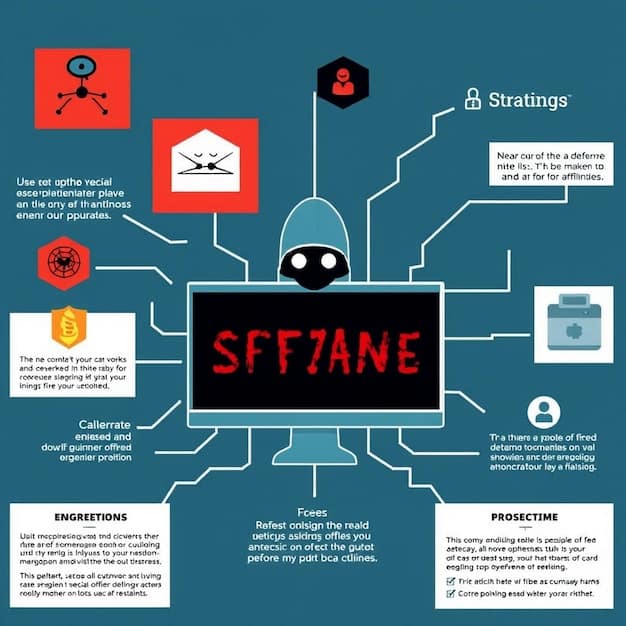AI Regulation: Unlocking the Potential Benefits

AI regulation can foster innovation by setting clear standards, increasing public trust, promoting ethical development, and ensuring accountability, leading to broader adoption and societal benefits.
The rise of artificial intelligence (AI) presents both incredible opportunities and potential risks. While AI promises to revolutionize industries and improve lives, concerns about bias, job displacement, and misuse have fueled the debate around whether and how to regulate this rapidly evolving technology. Understanding the potential benefits of AI regulation is crucial for shaping a future where AI serves humanity responsibly and ethically.
Why Consider AI Regulation?
Before diving into the potential benefits, it’s important to understand the rationale behind considering AI regulation in the first place. The core purpose revolves around mitigating potential downsides to ensure AI technologies are used responsibly and safely.
Regulation is not just about restriction; it is also about fostering a climate of innovation by clearly outlining accepted standards for AI development.

Addressing Ethical Concerns
AI algorithms are trained on data, and if this data reflects existing societal biases, the AI system will perpetuate and potentially amplify them. Regulation can mandate fairness, transparency, and accountability in AI systems used in sensitive areas.
- Bias Mitigation: Requirements for data diversity and bias detection can ensure fairer outcomes.
- Transparency: Explaining how AI systems arrive at decisions fosters trust and identifies potential flaws.
- Accountability: Establishing who is responsible when AI systems cause harm is essential for redress.
By proactively addressing ethical concerns through regulation, we can help prevent unintended consequences and build public trust in AI.
Fostering Innovation and Growth
It might seem counterintuitive, but AI regulation can positively contribute to innovation. A clear regulatory framework can provide a stable environment for businesses to invest in and develop AI systems.
When companies understand the ‘rules of engagement,’ they are more likely to create compliant, secure, and ethically sound AI solutions, thus driving sustainable growth within the sector.
Establishing Clear Standards
Regulations provide clear guidelines on what is acceptable and what is not. This clarity can reduce uncertainty for companies, encouraging them to invest in AI research and development.
- Encouraging Investment: Investors are more likely to back projects in stable regulatory environments.
- Level Playing Field: Fair competition is ensured by standardized regulations that prevent companies from cutting corners.
- Market Access: Meeting regulatory standards allows firms to access larger markets, boosting ROI and encouraging growth.
By setting clear standards for AI development, countries or regions can become attractive hubs for AI related business activities.
Increasing Public Trust in AI
Public acceptance is pivotal for the widespread adoption of AI. Trust cannot be assumed but must be earned. Regulation acts as a key element that helps to increase public trust.
When people trust that AI systems are designed and deployed responsibly, they are more predisposed to integrate AI into their daily lives, unlocking a myriad of innovative and helpful applications.
Building Confidence
Regulation can ensure that AI systems are safe, reliable, and used in ways that benefit society. Building public confidence is essential for realizing the full potential of AI.
When laws protect consumer rights and ensure data security, individuals are more likely to embrace AI technologies.

Promoting the Ethical Development of AI
Ethical AI development concentrates on creating AI systems that follow principles of fairness, transparency, and accountability. Regulation can play a vital role in promoting these ethical considerations.
When companies are legally obligated to follow ethical standards, they weave these principles into the foundation of AI systems, facilitating outcomes that are fair to all and in alignment with societal values.
Implementing Ethical Frameworks
Regulation can embed ethical frameworks into AI development processes, ensuring that ethical considerations are prioritized from the outset.
- Ethical Guidelines: Incorporating ethical codes and practices into AI systems promotes responsible development.
- Data Privacy: Strict regulations on data usage and protection safeguard individual rights and build user confidence.
- Algorithmic Transparency: Mandates for clear explanations for AI decision-making increase trust and understanding.
A framework bolstered by legal requirements further ensures adherence, transforming ethics from a value proposition to a compulsory practice.
Ensuring Accountability and Redress
One of the most pervasive concerns regarding AI is the ‘black box’ nature of many machine-learning algorithms. If an AI system causes harm, it can be difficult to determine who is responsible.
AI regulation can establish clear lines of accountability, guaranteeing that there are mechanisms in place for redress and compensation when AI systems cause damage or exhibit discriminatory behaviors.
Liability and Responsibility
Regulation can clarify liability for AI-related harms, ensuring that individuals and organizations are held accountable for the actions of their AI systems.
- Clear Legal Frameworks: Establishing liability rules for AI systems ensures that responsible parties can be held accountable for harm.
- Insurance and Compensation: Requirements for insurance coverage and compensation mechanisms provide recourse for those affected by AI accidents or errors.
- Oversight and Enforcement: Regulatory bodies tasked with monitoring AI systems and enforcing compliance promote accountability.
Such regulations, with precise definitions of fault and processes for legal recourse, ensure people harmed by AI have avenues for justice and amends.
Enhancing Security and Safety
AI systems are increasingly deployed in safety-critical applications, such as autonomous vehicles and medical diagnostics. Regulation can ensure that these systems are secure, reliable, and safe.
This emphasis on safety and security builds a foundation of confidence, fostering the extensive acceptance and integration of AI within crucial sectors, thus boosting overall safety for end-users and the general public.
Promoting Robustness
Regulation can require rigorous testing and validation of AI systems, ensuring that they are resilient to errors, attacks, and unforeseen circumstances.
- Security Standards: Setting security standards for AI systems protects against cyber threats and malicious use.
- Validation and Testing: Mandating thorough testing and validation procedures ensures that AI systems perform reliably and safely in real-world conditions.
- Continuous Monitoring: Implementing continuous monitoring and auditing mechanisms allows for quick detection and mitigation of potential risks.
AI regulations that prioritize safety, security, and reliability contribute considerably to the smooth incorporation of these potent technologies, while concurrently protecting society from possible harm.
| Key Aspect | Brief Description |
|---|---|
| 🛡️ Ethical AI | Ensures AI systems are fair, transparent, and unbiased. |
| 📈 Innovation | Promotes stable investment with clear standards. |
| 🔒 Security | Safeguards against cyber threats and ensures data privacy. |
| ⚖️ Accountability | Establishes clear liability for AI-related harms. |
Frequently Asked Questions (FAQ)
▼
AI regulation refers to the establishment of laws, guidelines, and standards aimed at governing the development, deployment, and use of artificial intelligence technologies. It seeks to address ethical, societal, and safety concerns.
▼
AI regulation can foster innovation by providing a stable and predictable environment for businesses to invest in AI development. Clear standards reduce uncertainty and encourage investment in ethical and safe AI.
▼
Public trust is crucial because the more people trust in the safety and ethical application of AI, the more they are willing to incorporate AI technologies into different aspects of their lives.
▼
Ethical frameworks in AI development are sets of rules and principles that guide the creation and use of AI systems. They ensure fairness, transparency, and accountability in AI decision-making and deployments.
▼
AI regulation ensures accountability by establishing liability rules, insurance requirements, and oversight bodies. When AI systems cause harm, regulatory setups clarify who is responsible and ensure that affected parties have legal recourse.
Conclusion
In conclusion, the potential benefits of AI regulation are vast and multifaceted. By fostering innovation, increasing public trust, promoting ethical development, ensuring accountability, and enhancing security, regulation can help unlock the full potential of AI while mitigating its risks. A carefully designed regulatory framework is essential for shaping a future where AI serves humanity in a responsible and beneficial manner.





